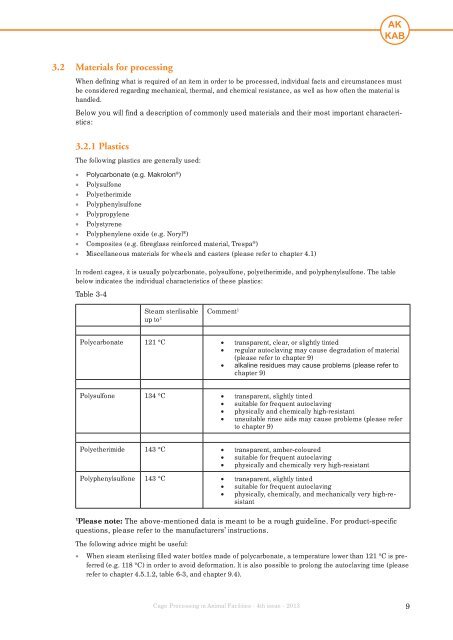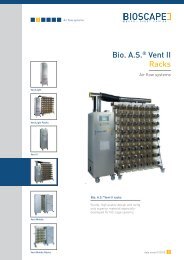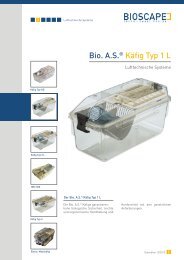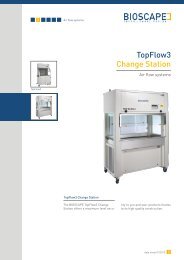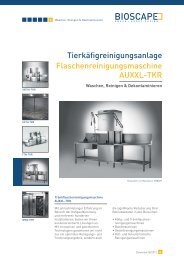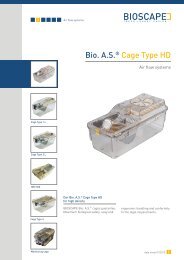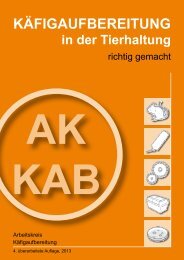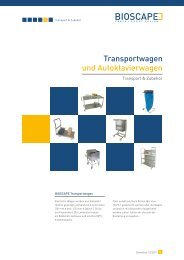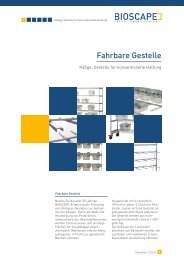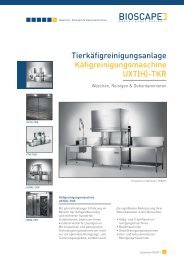CAGE PROCESSING in Animal Facilities - GV-SOLAS
CAGE PROCESSING in Animal Facilities - GV-SOLAS
CAGE PROCESSING in Animal Facilities - GV-SOLAS
Create successful ePaper yourself
Turn your PDF publications into a flip-book with our unique Google optimized e-Paper software.
3.2 Materials for process<strong>in</strong>gWhen def<strong>in</strong><strong>in</strong>g what is required of an item <strong>in</strong> order to be processed, <strong>in</strong>dividual facts and circumstances mustbe considered regard<strong>in</strong>g mechanical, thermal, and chemical resistance, as well as how often the material ishandled.Below you will f<strong>in</strong>d a description of commonly used materials and their most important characteristics:3.2.1 PlasticsThe follow<strong>in</strong>g plastics are generally used:• Polycarbonate (e.g. Makrolon ® )• Polysulfone• Polyetherimide• Polyphenylsulfone• Polypropylene• Polystyrene• Polyphenylene oxide (e.g. Noryl ® )• Composites (e.g. fibreglass re<strong>in</strong>forced material, Trespa ® )• Miscellaneous materials for wheels and casters (please refer to chapter 4.1)In rodent cages, it is usually polycarbonate, polysulfone, polyetherimide, and polyphenylsulfone. The tablebelow <strong>in</strong>dicates the <strong>in</strong>dividual characteristics of these plastics:Table 3-4Steam sterilisableup to 1 Comment 1Polycarbonate 121 °C • transparent, clear, or slightly t<strong>in</strong>ted• regular autoclav<strong>in</strong>g may cause degradation of material(please refer to chapter 9)• alkal<strong>in</strong>e residues may cause problems (please refer tochapter 9)Polysulfone 134 °C • transparent, slightly t<strong>in</strong>ted• suitable for frequent autoclav<strong>in</strong>g• physically and chemically high-resistant• unsuitable r<strong>in</strong>se aids may cause problems (please referto chapter 9)Polyetherimide 143 °C • transparent, amber-coloured• suitable for frequent autoclav<strong>in</strong>g• physically and chemically very high-resistantPolyphenylsulfone 143 °C • transparent, slightly t<strong>in</strong>ted• suitable for frequent autoclav<strong>in</strong>g• physically, chemically, and mechanically very high-resistant1Please note: The above-mentioned data is meant to be a rough guidel<strong>in</strong>e. For product-specificquestions, please refer to the manufacturers’ <strong>in</strong>structions.The follow<strong>in</strong>g advice might be useful:• When steam sterilis<strong>in</strong>g filled water bottles made of polycarbonate, a temperature lower than 121 °C is preferred(e.g. 118 °C) <strong>in</strong> order to avoid deformation. It is also possible to prolong the autoclav<strong>in</strong>g time (pleaserefer to chapter 4.5.1.2, table 6-3, and chapter 9.4).Cage Process<strong>in</strong>g <strong>in</strong> <strong>Animal</strong> <strong>Facilities</strong> · 4th issue · 2013 9


